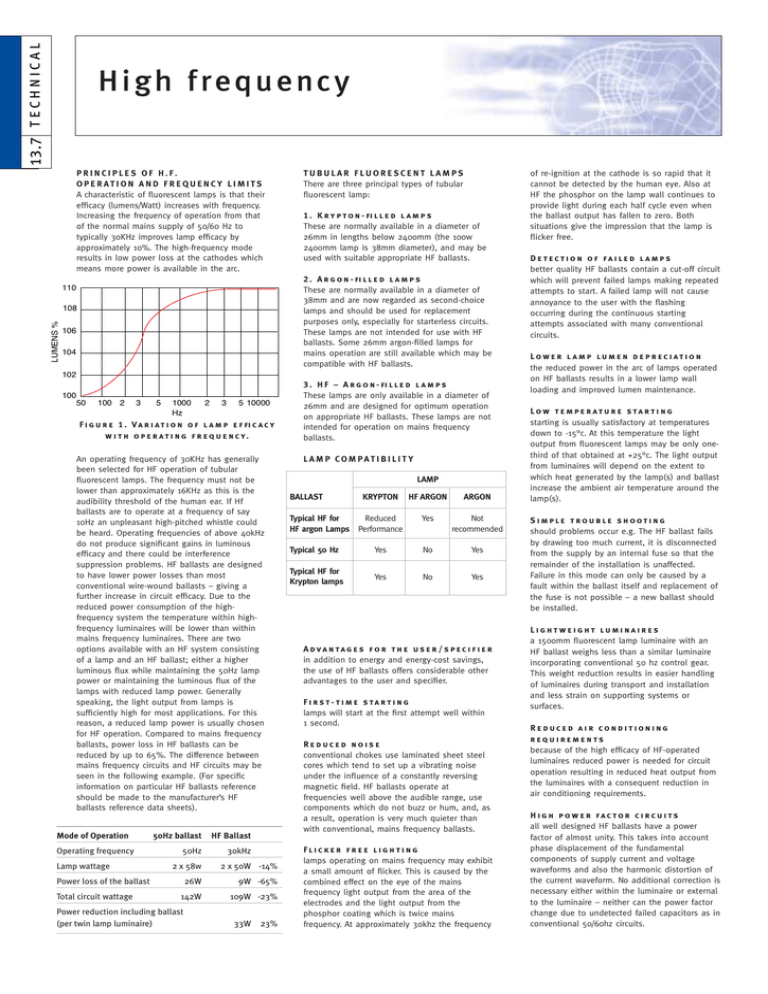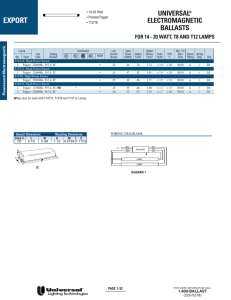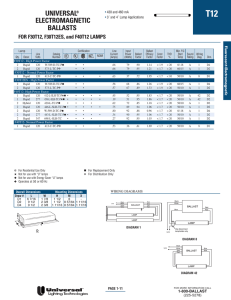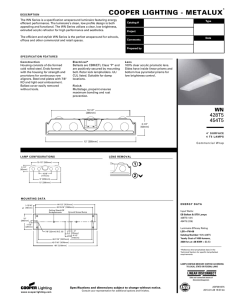High frequency
advertisement

13.7 T E C H N I C A L H i g h f re q u e n c y PRINCIPLE S OF H.F. OPERATION AND FREQUENCY LIMITS A characteristic of fluorescent lamps is that their efficacy (lumens/Watt) increases with frequency. Increasing the frequency of operation from that of the normal mains supply of 50/60 Hz to typically 30KHz improves lamp efficacy by approximately 10%. The high-frequency mode results in low power loss at the cathodes which means more power is available in the arc. 1. Krypton-filled l amps These are normally available in a diameter of 26mm in lengths below 2400mm (the 100w 2400mm lamp is 38mm diameter), and may be used with suitable appropriate HF ballasts. 2. Argon-filled lamps These are normally available in a diameter of 38mm and are now regarded as second-choice lamps and should be used for replacement purposes only, especially for starterless circuits. These lamps are not intended for use with HF ballasts. Some 26mm argon-filled lamps for mains operation are still available which may be compatible with HF ballasts. 110 108 LUMENS % TUBULAR FLUORESCENT LAMPS There are three principal types of tubular fluorescent lamp: 106 104 102 100 50 100 2 3 5 1000 Hz 2 3 5 10000 Fi g u r e 1 . Va r i at i o n o f l a m p e f fi c a c y w i t h o p e r a t i n g f r e q u e n c y. An operating frequency of 30KHz has generally been selected for HF operation of tubular fluorescent lamps. The frequency must not be lower than approximately 16KHz as this is the audibility threshold of the human ear. If Hf ballasts are to operate at a frequency of say 10Hz an unpleasant high-pitched whistle could be heard. Operating frequencies of above 40kHz do not produce significant gains in luminous efficacy and there could be interference suppression problems. HF ballasts are designed to have lower power losses than most conventional wire-wound ballasts – giving a further increase in circuit efficacy. Due to the reduced power consumption of the highfrequency system the temperature within highfrequency luminaires will be lower than within mains frequency luminaires. There are two options available with an HF system consisting of a lamp and an HF ballast; either a higher luminous flux while maintaining the 50Hz lamp power or maintaining the luminous flux of the lamps with reduced lamp power. Generally speaking, the light output from lamps is sufficiently high for most applications. For this reason, a reduced lamp power is usually chosen for HF operation. Compared to mains frequency ballasts, power loss in HF ballasts can be reduced by up to 65%. The difference between mains frequency circuits and HF circuits may be seen in the following example. (For specific information on particular HF ballasts reference should be made to the manufacturer’s HF ballasts reference data sheets). Mode of Operation Operating frequency Lamp wattage 50Hz ballast 50Hz 2 x 58w Power loss of the ballast Total circuit wattage HF Ballast 30kHz 2 x 50W -14% 26W 9W -65% 142W 109W -23% Power reduction including ballast (per twin lamp luminaire) 33W 23% 3. HF – Argon-filled lamps These lamps are only available in a diameter of 26mm and are designed for optimum operation on appropriate HF ballasts. These lamps are not intended for operation on mains frequency ballasts. LAMP COMPATIBILIT Y LAMP BALLAST KRYPTON HF ARGON ARGON Typical HF for Reduced HF argon Lamps Performance Yes Not recommended Typical 50 Hz Yes No Yes Typical HF for Krypton lamps Yes No Yes Advantages for the user/specifier in addition to energy and energy-cost savings, the use of HF ballasts offers considerable other advantages to the user and specifier. Fir st-time starting lamps will start at the first attempt well within 1 second. Reduced noise conventional chokes use laminated sheet steel cores which tend to set up a vibrating noise under the influence of a constantly reversing magnetic field. HF ballasts operate at frequencies well above the audible range, use components which do not buzz or hum, and, as a result, operation is very much quieter than with conventional, mains frequency ballasts. Fl i c k e r f r e e l i g h t i n g lamps operating on mains frequency may exhibit a small amount of flicker. This is caused by the combined effect on the eye of the mains frequency light output from the area of the electrodes and the light output from the phosphor coating which is twice mains frequency. At approximately 30khz the frequency of re-ignition at the cathode is so rapid that it cannot be detected by the human eye. Also at HF the phosphor on the lamp wall continues to provide light during each half cycle even when the ballast output has fallen to zero. Both situations give the impression that the lamp is flicker free. D e t ec t i o n o f fa i l e d l a m p s better quality HF ballasts contain a cut-off circuit which will prevent failed lamps making repeated attempts to start. A failed lamp will not cause annoyance to the user with the flashing occurring during the continuous starting attempts associated with many conventional circuits. Lowe r l a m p lum e n d e p r ec i at i o n the reduced power in the arc of lamps operated on HF ballasts results in a lower lamp wall loading and improved lumen maintenance. Low t e m pe r at u r e sta rt i n g starting is usually satisfactory at temperatures down to -15°c. At this temperature the light output from fluorescent lamps may be only onethird of that obtained at +25°c. The light output from luminaires will depend on the extent to which heat generated by the lamp(s) and ballast increase the ambient air temperature around the lamp(s). S i m pl e t r o u b l e s h o ot i n g should problems occur e.g. The HF ballast fails by drawing too much current, it is disconnected from the supply by an internal fuse so that the remainder of the installation is unaffected. Failure in this mode can only be caused by a fault within the ballast itself and replacement of the fuse is not possible – a new ballast should be installed. Lightweight luminaires a 1500mm fluorescent lamp luminaire with an HF ballast weighs less than a similar luminaire incorporating conventional 50 hz control gear. This weight reduction results in easier handling of luminaires during transport and installation and less strain on supporting systems or surfaces. Reduced air conditioning requirements because of the high efficacy of HF-operated luminaires reduced power is needed for circuit operation resulting in reduced heat output from the luminaires with a consequent reduction in air conditioning requirements. H i g h p ow e r fa c to r c i r c u i t s all well designed HF ballasts have a power factor of almost unity. This takes into account phase displacement of the fundamental components of supply current and voltage waveforms and also the harmonic distortion of the current waveform. No additional correction is necessary either within the luminaire or external to the luminaire – neither can the power factor change due to undetected failed capacitors as in conventional 50/60hz circuits.



